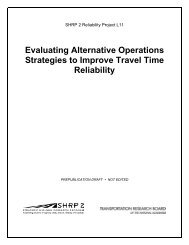Land Use and Traffic Congestion - SSTI
Land Use and Traffic Congestion - SSTI
Land Use and Traffic Congestion - SSTI
You also want an ePaper? Increase the reach of your titles
YUMPU automatically turns print PDFs into web optimized ePapers that Google loves.
These findings tended to corroborate responses elicited from participants in the project’s<br />
survey of officials. For this survey, which was conducted early in the project, researchers<br />
distributed 423 questionnaires <strong>and</strong> received 134 responses from a diverse list of elected<br />
officials, planning <strong>and</strong> zoning officials, transportation planners, <strong>and</strong> members of other<br />
relevant disciplines in the Phoenix, Tucson, <strong>and</strong> Flagstaff metropolitan areas. Some of the<br />
key discoveries in this investigation are given below:<br />
<strong>Traffic</strong> <strong>Congestion</strong> Concerns: While important, traffic congestion was rated as<br />
less a factor in project review than were issues of compatibility with adopted<br />
plans <strong>and</strong> impact on surrounding neighborhoods <strong>and</strong> businesses.<br />
Familiarity: Most officials were familiar with mixed-use concepts, had been<br />
involved in the review of these concepts, <strong>and</strong> had even encouraged submission of<br />
such projects.<br />
Transportation Impacts: The overwhelming majority of officials responding<br />
believed that compact, mixed-use development would increase transit use <strong>and</strong><br />
nonmotorized travel, though only about one-third felt unequivocally that it would<br />
lead to less traffic congestion. (Most were unsure.)<br />
Desirability: The great majority believed that the region would benefit from more<br />
mixed-use centers <strong>and</strong> corridors, focusing employment in centers <strong>and</strong> corridors,<br />
<strong>and</strong> building more mixed-use communities. About 80 percent believed that their<br />
own community would support compact, mixed-use development.<br />
Residential/retail <strong>and</strong> office/retail mixed use were the most highly rated<br />
combinations.<br />
These findings suggest an opportunity to advance the dialogue on <strong>and</strong> support for<br />
compact, mixed-use development in Arizona’s metropolitan areas. Among the initiatives<br />
that might be considered are the following:<br />
Education: There is a need to better inform the public, the business community,<br />
<strong>and</strong> officials about the nature <strong>and</strong> benefits of compact, mixed use. Themes<br />
developed in this project can serve as educational messages.<br />
Better Analysis Tools: Local planners <strong>and</strong> planning commissions are still using<br />
traditional traffic engineering approaches to assess the impact of development<br />
projects. By looking only at traffic congestion levels on adjacent links, ignoring<br />
through travel, <strong>and</strong> failing to account for the efficiencies of mixed-use<br />
development on lower vehicle trip rates <strong>and</strong> VMT, progressive projects are likely<br />
to be rejected or unreasonably downsized. The metropolitan planning<br />
organizations should take steps to add 4D enhancements to their existing tools.<br />
Visioning <strong>and</strong> Plan Overhauls: Existing long-range or comprehensive plans<br />
may be silent or devoid of a position on compact, mixed-use development.<br />
Regional or local targeted visioning exercises can raise visibility <strong>and</strong><br />
underst<strong>and</strong>ing of the issues, leading to greater acceptance <strong>and</strong> support in updated<br />
plans.<br />
Incentives: Adoption of compact, mixed-use development approaches can be<br />
encouraged in various ways. Grant monies <strong>and</strong>/or technical assistance can be<br />
offered to support studies or demonstration projects. Several states prioritize state<br />
program or grant funding based on demonstrated steps by a jurisdiction to<br />
embrace <strong>and</strong> incorporate key elements in their plans, codes, or procedures.<br />
5<br />
145 of 226















